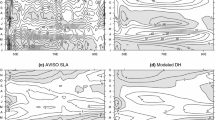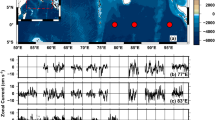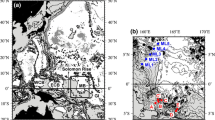Abstract
The present study offers a description of long equatorial wave propagation and reflection in the Indian Ocean as observed by the TOPEX/POSEIDON satellite. The equatorial longwave amplitudes are computed from January 1993 until December 1998, focusing on Kelvin (K) and first Rossby (R1) modes. The K wave is observed to propagate with a baroclinic phase speed close to 2 m/s while the R1 has a phase speed of 0.7 m/s. Wave reflections at both eastern and western boundaries are clearly observed during the entire period. At the eastern boundary K reflects into R1 with a reflection coefficient of 1.04 (reflection efficiency of 85% of that of an infinite meridional wall), and at the western boundary R1 reflects into K with a coefficient of 0.50 on average although a large seasonal and interannual variability of the reflection efficiency of the African coast is observed. Reflected K waves strongly influence the R1 variability near the western boundary as far as 60°E. Reflected R waves in turn, influence the K variability near the eastern boundary as far as 80°E. Although long equatorial waves are mainly forced by the changes in the winds during the inter-monsoon periods, reflection have a strong influence on the ocean's variability over a large part of the basin on both seasonal and interannual time scales. Focusing on the seasonal cycle of long equatorial waves (computed over 1993–1996), it is found that the constructive/destructive interaction between the wind forcing and wave reflection is responsible for the K (or R1) seasonal cycle to show a semi-annual (or annual) period near the western (or eastern) boundary. In 1994 and 1997–98, strong interannual easterlies coincident with El Niño onsets in the Pacific occurred in the Indian Ocean. Long equatorial wave propagation and reflection play a major role in creating an east–west sea level gradient along the equator, suggesting that wave dynamics and wave reflection may play a significant role in the Indian dipole mode suggested by several authors.
Similar content being viewed by others
Author information
Authors and Affiliations
Additional information
Received: 4 October 1999 / Accepted: 22 August 2000
Rights and permissions
About this article
Cite this article
Le Blanc, JL., Boulanger, JP. Propagation and reflection of long equatorial waves in the Indian Ocean from TOPEX/POSEIDON data during the 1993–1998 period. Climate Dynamics 17, 547–557 (2001). https://doi.org/10.1007/s003820000128
Issue Date:
DOI: https://doi.org/10.1007/s003820000128




